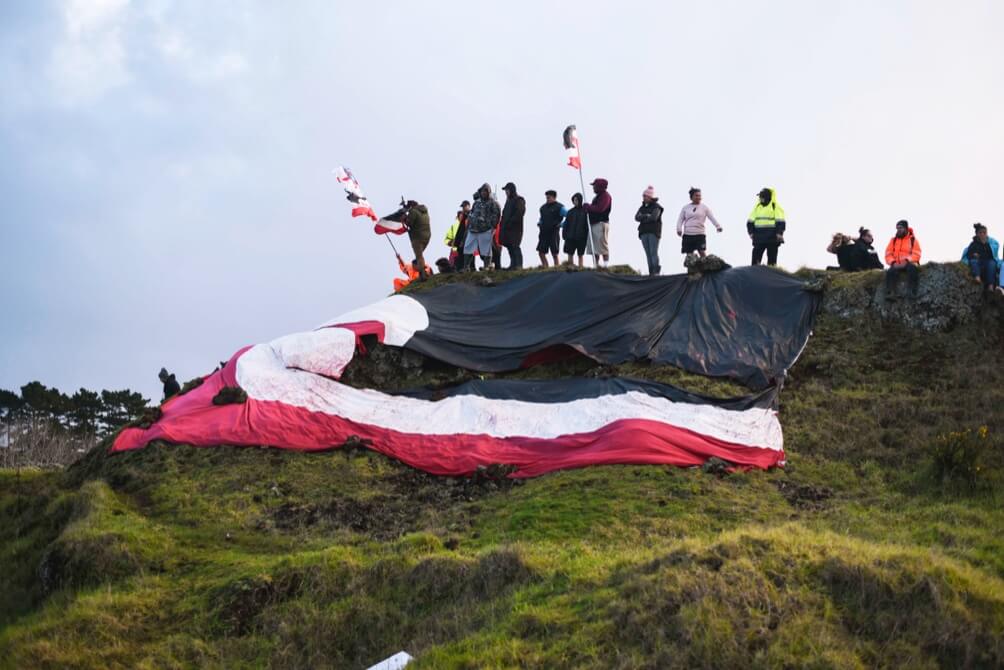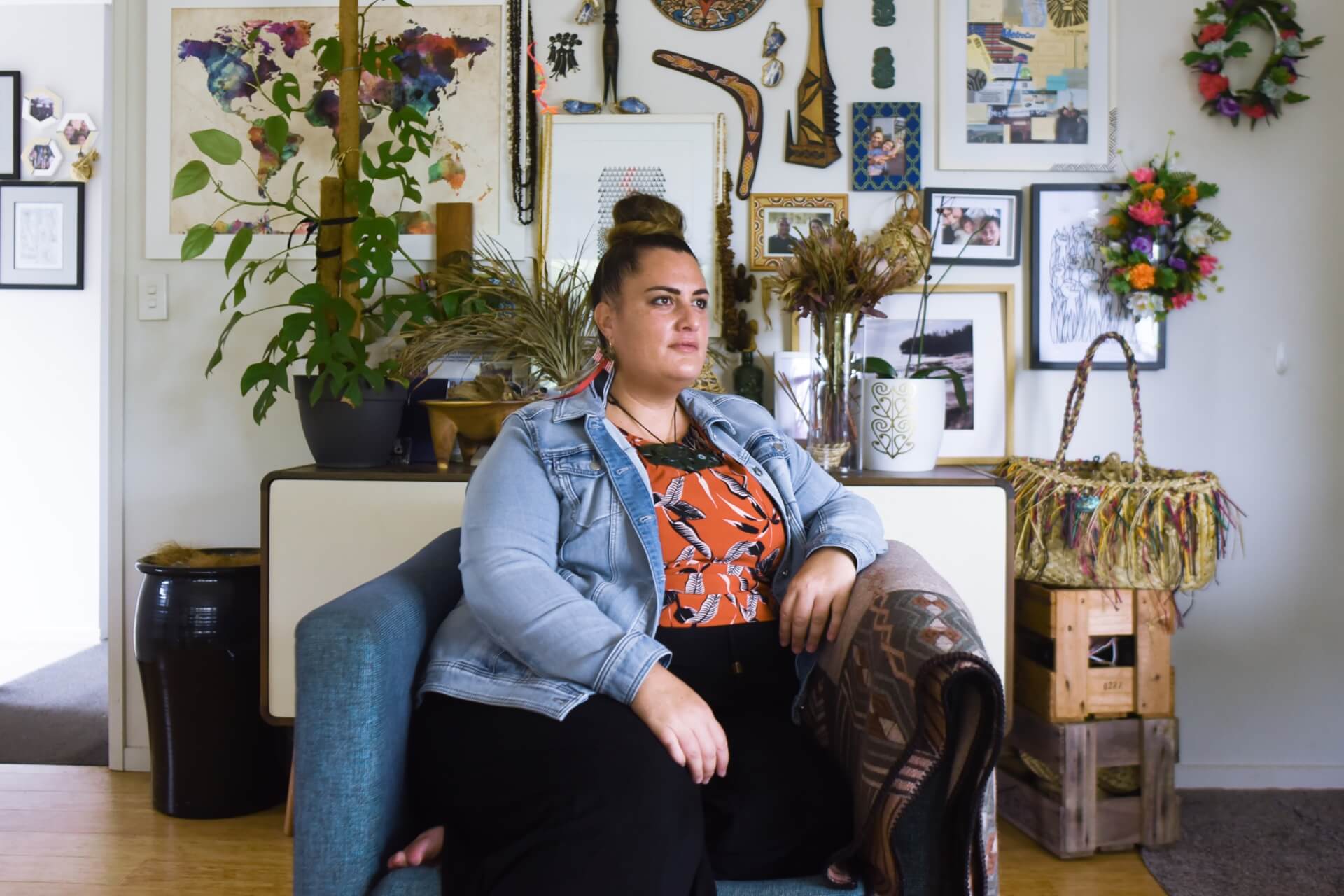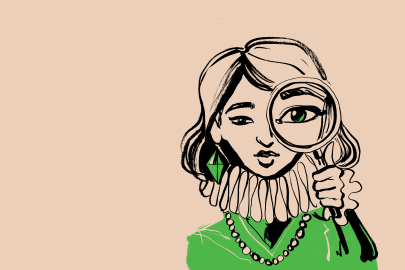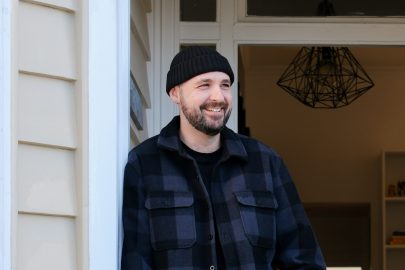Mar 22, 2022 Society
I’m sitting on the back porch of Qiane Matata-Sipu’s home in Ihumātao. Three years ago, the neighbouring land blocks were rumbling with thousands of people fighting to protect the whenua against development. It’s quiet today, but the spiritual and historical significance of that whenua remains. This is Matata-Sipu’s papakāinga, a place her tīpuna once lived. The whenua was gifted by her nana, Dawn, who has passed away, on the condition that it remains in their whānau forever.
“I owe everything to the fact that we got this house, because everything that’s happened in my life since has been a result of being here on the pā,” she says. “And what I love is that my daughter, Haeata te Kapua, has an opportunity to grow up around her whānau and next to her marae. I grew up exactly the same way.”
It’s no wonder Matata-Sipu fought so tirelessly to protect her whenua. She points behind us to the table where the movement to save Ihumātao all started — where her cousins, aged from their mid-20s to early 30s, gathered over kai and decided to form SOUL (Save Our Unique Landscape). The movement fought a six-year-long battle against Fletcher Building’s attempt to develop the whenua, one of the oldest sites of settlement in Auckland, into a multimillion-dollar housing estate.
“We were very naive, but we were never going to give up,” she says. “And I think that’s what so many people underestimated. [Fletcher Building] would just lose money, but we had our whole existence to lose . We had such a bigger driving force. So even though we weren’t sure where it was going to go, we knew we were never going to give up.”
This November marks the sixth anniversary of SOUL’s occupation at Ihumātao. Although the movement would go on to win their battle — the Government purchased the whenua from Fletcher Building and pledged to return it — Matata-Sipu is frank in her assessment of the personal toll the battle took. “What people don’t know is that there is still trauma from Ihumātao,” she says.
In July 2019, police made a move to evict SOUL from the whenua, sending in hundreds of officers to enforce Fletcher Building’s trespass order. SOUL’s kaitiaki village was deconstructed and police lines were established to protect construction trucks. For a brief moment, it seemed as if SOUL had lost. But after calls for solidarity went out on social media, hundreds and then thousands of supporters turned out over a series of weeks to help protect the whenua. “No one really addressed the fact that there was a whole lot of stuff that we as whānau carry, such as the mamae of having police coming onto your whenua, the responsibility of looking after 10,000 people, making sure that nothing went wrong because it would fuck up the whole five years of mahi, and the actual trauma of possibly losing your whenua. Not working, not having an income, and then also having tamariki. We had a baby that needed a full-time parent and you have to consciously choose to not be with your whānau, and I carry a lot of guilt from that.”
This was one of the many unseen sacrifices that took place during SOUL’s occupation. Pania Newton, one of Matata-Sipu’s cousins and often the public face of the movement, also gave birth, with the arrival of her pēpi almost perfectly coinciding with the Government’s announcement that it would acquire the whenua in dispute and return it to mana whenua.

Ihumātao
At 36, Matata-Sipu is what might be described as a high achiever. She is not only a committed activist, she is also the author and creator of NUKU, a movement that profiles and celebrates 100 Indigenous wāhine. NUKU the book was released in November and has already sold more than 3000 copies as well as making the shortlist for the Ockham New Zealand Book Awards. In February, she also took home the culture and arts category at the NZ Women of Influence Awards for her work on the project. “Most of the time we had no money and none of my team were paid what they were worth,” she says. “It was a lot of sacrifice. When I was holding the book in my hand, I was very, very proud.”
While Matata-Sipu has strong whakapapa ties to Ihumātao, she also has whakapapa to Te Waiohua, Waikato-Tainui, Ngāpuhi, Ngāti Pikiao, and the Cook Islands. She grew up in South Auckland, raised by her grandparents in Māngere Bridge, but her childhood memories are mostly of her marae at Ihumātao. Her strong connection to the marae is at the heart of who she is today. She remembers tagging along with her grandfather and helping to set up for hui. She was eight years old when she went to her first marae meeting and 16 when she became the chairperson of the Hauora committee.
“My relationship with my marae was part of my everyday life,” she says. “It’s one privilege I always recognise. I don’t know what it’s like to not have my marae. Our marae is almost more important than our iwi in terms of how we as a whānau connect and how we as a whānau operate.”
Although Matata-Sipu knows the stories of her marae intimately, she says it’s hard not being able to express herself in te reo Māori. “You’re born and raised on a marae and you still sit there and get half the conversation,” she says. “You can’t fully participate in that space. And so it’s not like you’re less than, but you’re not fully there, which is the whole concept around wholeness.”
Matata-Sipu’s birth father is Australian — something she doesn’t talk about much publicly — and she has met him only once. “I haven’t seen him for 18 years. I realised that, because my husband and I just celebrated 18 years together in December.”
So although she says she has always felt proud to be Māori, she hasn’t always felt accepted. “I had a very white name, I’m fair-skinned, and my reo wasn’t amazing, so there were times throughout my life when I felt not Māori enough or like I didn’t quite know where I fit.”
One of those times was at the mainstream high school she attended. “It was probably some of the more obvious times of my life, where I was grappling with my own identity and the context of where I was,” she says. “I remember there was this little half fence that separated the te reo unit from the mainstream unit. There was a very clear distinction between mainstream versus the Māori side. And my cousins would be on the other side of the fence.”
And when Matata-Sipu, who was a top student, expressed her interest in studying journalism at AUT, her careers teacher told her she should “choose something else”. “I was the co-head girl, the dux of my year, and I had the careers teacher believing I couldn’t do it,” she says. “Ronji Tanielu was promoting AUT and I remember him saying to me, ‘You should apply for the vice chancellor’s scholarship’, and now I think, the white lady was, like, you’re not going to get in, but the Sāmoan man was, like, you should apply for the biggest scholarship they have. He believed in me and I got it.”
At university, Matata-Sipu says, she was the “token Māori” on her communications-degree course and struggled to find her place. “I kind of just floated in between. There wasn’t anyone really like me. It was in the city and everyone wore make-up and dressed like a fashion show. They were so different; most of them came from money. People would come and ask me all the Māori questions, and I’m like, ‘I don’t know, google it’.”
Because of her experience at high school and university, when she left university for the communications sector she was wary of falling into a media typecast of being assigned the Māori and Pasifika stories. But, despite that wariness, she found herself working at Mana, once New Zealand’s leading Māori magazine. This is where she learnt everything from production to answering phone calls, from flat planning to advertising, and from photography to writing. This experience and the skills she took from it led her to start her own business, QIANE+co.
But in 2015, life changed dramatically after attending a hui at Makaurau Marae and hearing a rumour that a development was to be built at Ihumātao. “There weren’t a lot of people who came to marae meetings back in those days,” she said. “I remember our whānau saying to me, ‘You guys go and find out more information and bring it back.’ And we found out that it was a Fletchers development. We did the call-out when Pania asked everybody to come down to Ihumātao and people started showing up. We never, ever imagined the amount of people who would show up on the whenua. We had 10,000 in that first week.”
Matata-Sipu’s late Nana Dawn was a huge influence on her, telling her and SOUL to “just do it”. “I had mamae for my grandfather, too, because if he was still alive, he would have said no [to development] and our whole family would have fallen in line straight away,” she says.
But “when they both died, that kind of mana never moved to anyone else. And so there was no real authority of one person to say something. We were in our 20s and 30s, forced into a space where we had to step up.”
Matata-Sipu made the conscious choice to work in the background on communications and strategy while Newton became the public face of the movement. SOUL started social media pages, distributed posters, sent out press releases, spoke at events, attended hui, and eventually constructed a kaitiaki village for the “land protectors”.
“In those really early days, it was just trying to figure out what we were doing and how,” she says. “I was still wanting to have my baby and so my close friend, who’s a rongoā practitioner, said to me, ‘You need to choose which whenua you are going to fight for because you can’t fight for them both at the same time.’ I had to choose — was I going to be in the public or do I take a step back and figure out how to still be involved while trying to have my baby?”
The fight to save Ihumātao took seven years of Matata-Sipu’s life. In that time, she gave birth to Haeata te Kapua, her nana died, and she launched NUKU. The word NUKU is derived from Papatūānuku, meaning Earth mother, and is dedicated to her daughter.
“If I die tomorrow, I know I did everything to protect her whenua, that she’s secure in knowing who she is in her identity and that knows she can be anything she wants to be by giving her all these examples.”
In December 2020, Finance Minister Grant Robertson announced that the Government would release $30 million to purchase the whenua from Fletcher Building. He told media that Ihumātao risked becoming his “generation’s Bastion Point”. It was a victory for Matata-Sipu and SOUL, with the Government opening the door to eventually returning the land to the people maintaining ahi kaa on it. It was also a vindication of their special relationship to the whenua and their years of activism to protect it.
NUKU launched at the Māngere Arts Centre — Ngā Tohu o Uenuku in 2017. It took three years to profile all 100 women across the podcast and its accompanying video and book. Many are well known, from media personalities Stacey Morrison and Kanoa Lloyd to the singer and song-writer Hinewehi Mohi. Others are not as recognisable but are making enormous contributions to their communities, such as 14-year-old Georgia Latu, the entrepreneur behind the poi and jewellery company Pōtiki Poi. The NUKU series is one of the most popular local podcasts in New Zealand, charting on both Apple Podcasts and Spotify with more than 140,000 plays.
But none of this came without a struggle, Matata-Sipu says. “It was the hardest, most stressful, most traumatic time of my life, yet the most rewarding and most beautiful.” NUKU was also grossly underfunded, and public funding applications were declined several times. “We just begged and borrowed and made it work somehow.”
She refused to “monetise” NUKU, wanting it to be accessible to everyone. While Creative NZ and the Tindall Foundation donated to the kaupapa, $50,000 came from the public in a crowdfunding campaign. “I think we survived on about $150,000 in funding over three years … I don’t think we ever comprehended what aroha people had for NUKU, and as a team we just were so overwhelmed. We ugly-cried for days.
“The thing that I really love about NUKU was that we stuck to our kaupapa. The integrity of NUKU was never compromised.”
NUKU is tīpuna driven, Matata-Sipu says. She’s proud of the team of Indigenous women who are the heart and soul of the NUKU kaupapa. “I’ve been really privileged to witness my friends grow and thrive. It’s changed me significantly, but also to see the change in each woman.”
Matata-Sipu’s childhood friend Mel Harema did the hair and make-up and has her own salon in Mt Albert called The Spot. “When I look at Melissa, her sense of identity has really thrived. I never thought I would ever hear her talking about moko kauae for herself — ever. And now she’s got these different kinds of ways that she sees herself in the world.
“Then there’s Taylor Aumua, the lead videographer, who wants to work for National Geographic one day. I told her in the beginning of NUKU, I’ve got this idea, jump on board. Seeing Taylor grow and really submit to who she is and what she wants to do while acknowledging her gifts has been beautiful. And there’s former production man- ager Julia Espinoza and current one Emma O’ Reilly, who have both come into their own.”
NUKU the book is self-published. For Matata-Sipu, retaining control over the content and distribution aligns with story sovereignty and mana motuhake. But without an established publisher’s distribution network it was difficult to push the book into the public sphere. Mainstream bookstores turned her down despite the enormous success of the NUKU podcast. Now NUKU has sold out on its six-location book tour. This is uncommon for a Māori-focused book of any kind, let alone one focused on Māori women.
But, as she says, “NUKU is a safe space,” perhaps explaining its popularity with Māori and non-Māori readers. “Non-Māori can safely learn more about Māori and Pasifika and not feel like they’re using people’s time or encroaching in their space. It helps them better understand lived experiences that are not theirs.
“I had whānau tell me their kids were doing school assignments on the NUKU wāhine and that makes me cry. How amazing it is that our rangatahi are not talking about Joan of Arc for their assignments, they’re talking about our wāhine taki taki and the amazing contribution they’re making in the world. That’s fucking cool.”
Her māmā, Karen Matata, was NUKU woman #100. It was an emotional moment for Matata-Sipu, especially coming at the end of a life-changing kaupapa like Ihumātao. “There was a level of healing that happened within NUKU,” she says. “When you interview people, you hear them all the time talking about wanting to reconnect with their whakapapa or wanting to find their reo. When it’s within your own lines and when you interview your own mother, you feel the emotions.
“I also never got to capture my nana’s story and it’s one of the biggest regrets I have. She would ask me, and I’d always be like, ‘I’ll get to it.’ I never got to capture her portraits and her story the way I capture these women. Every single wāhine I met helped with my healing. It’s been a hard seven years.”
It’s around this time in the interview that daughter Haeata te Kapua bursts through the door from kohanga with a big smile on her face. She’s the ‘miracle baby’ that Matata-Sipu and husband Will took 14 years to conceive. She can speak three languages — te reo Māori, Tongan, and English.
“I really am jealous that my husband knows his Tongan language and he can confidently teach our daughter that language,” she says. “While my kōtiro is at an age where she absorbs our reo, I need to equip myself so that I can ensure that I’m passing that on to her. I want all of my tamariki and moko to be trilingual.”
It’s one of the many reasons behind Matata-Sipu’s decision to study full-time immersion te reo Māori at Te Wānanga Takiura o Ngā Kura Kaupapa Māori o Aotearoa in Mt Albert this year. The journey she is about to undertake is perhaps her biggest challenge yet. “I find myself feeling less than whole without my reo,” she says.
While she says she has whakaaro Māori and knowledge around tikanga and kawa, for her it’s still not enough. “I have always wanted to be a fluent te reo Māori speaker my whole life because I’ve never thought that I can express myself well enough in Pākehā. Everything for me has a meaning, every single part of my life has a connection to te ao wairua and I always think about how I can’t express myself the way that I know I really want to.
“I can do a basic karanga but I can’t karanga the way I want to. I want to spin the whole world around with my karanga. I want the wairua to be dancing in the middle of a karanga.
“That’s not to say that you have to have your language to be whole. But for me personally, I still feel like there’s parts of me that’s missing. And at some point, you have to invest in yourself. And there’s never been a right time and I still don’t even think now is the right time.”
Matata-Sipu’s nana “could understand reo Māori but wouldn’t speak it. Her mother and father had told her she wouldn’t get anywhere in the world with te reo Māori.”
And her grandfather Jones (Joe) Matata was a fluent Māori speaker. “He could speak the most simple te reo. Never mind this flash stuff everybody does today. I get really frustrated that my grandfather didn’t korero to me in reo because his reo was so beautiful, but that’s okay. I would love to know that when I die, I can walk up to him and just have an entire conversation in te reo Māori.
I’m so confident in the fact that my life is driven by my tīpuna that at some point, I’ll be able to mihi to my tīpuna and acknowledge them for the path I’ve been able to take.”
Full-immersion te reo Māori has its own challenges — a journey I undertook myself last year. There’s the unlearning parts of ourselves and trying to overcome trauma, both intergenerational and individual trauma from learning a language beaten from our ancestors. It’s an emotional and heavy journey.
“I’m so proud of you and I’m so inspired by that,” Matata-Sipu tells me. “You and Kiri [Nathan, a previous full-immersion student] and my friends who have done full immersion have given me so much hope and inspiration and it makes me feel more confident about my journey because people I know who I love and respect, who I know work really hard, were able to do it. And so if I commit, I can also do it. And that gives me inspiration.
“It does make me really self-conscious when people look at me and think, well, you’ve grown up on your marae, you’ve done all this stuff with your iwi Māori, you could probably talk to your daughter and have a conversation, so you’ll be fine. And I’m actually, like, no, that’s not the case. I’ve gone through 36 years of my life where people say you’ll be fine. And I haven’t been fine without my reo. When we talk about people’s te reo Māori journeys, we just can’t assume.”
Matata-Sipu will take a step back from mahi this year but she’ll share parts of her learning journey on her NUKU podcast. “I don’t think that total immersion is necessary for everyone to learn te reo,” she says. “But for me and the way I am, I’m all in. And so I will become obsessed with learning my reo and it will become my whole life.”
It’s the first time in a long time Matata-Sipu has been able to sit and reflect on the last year. “I’m not good at resting,” she says.
–
This column was published in Metro 434.
Available here in print and pdf.







